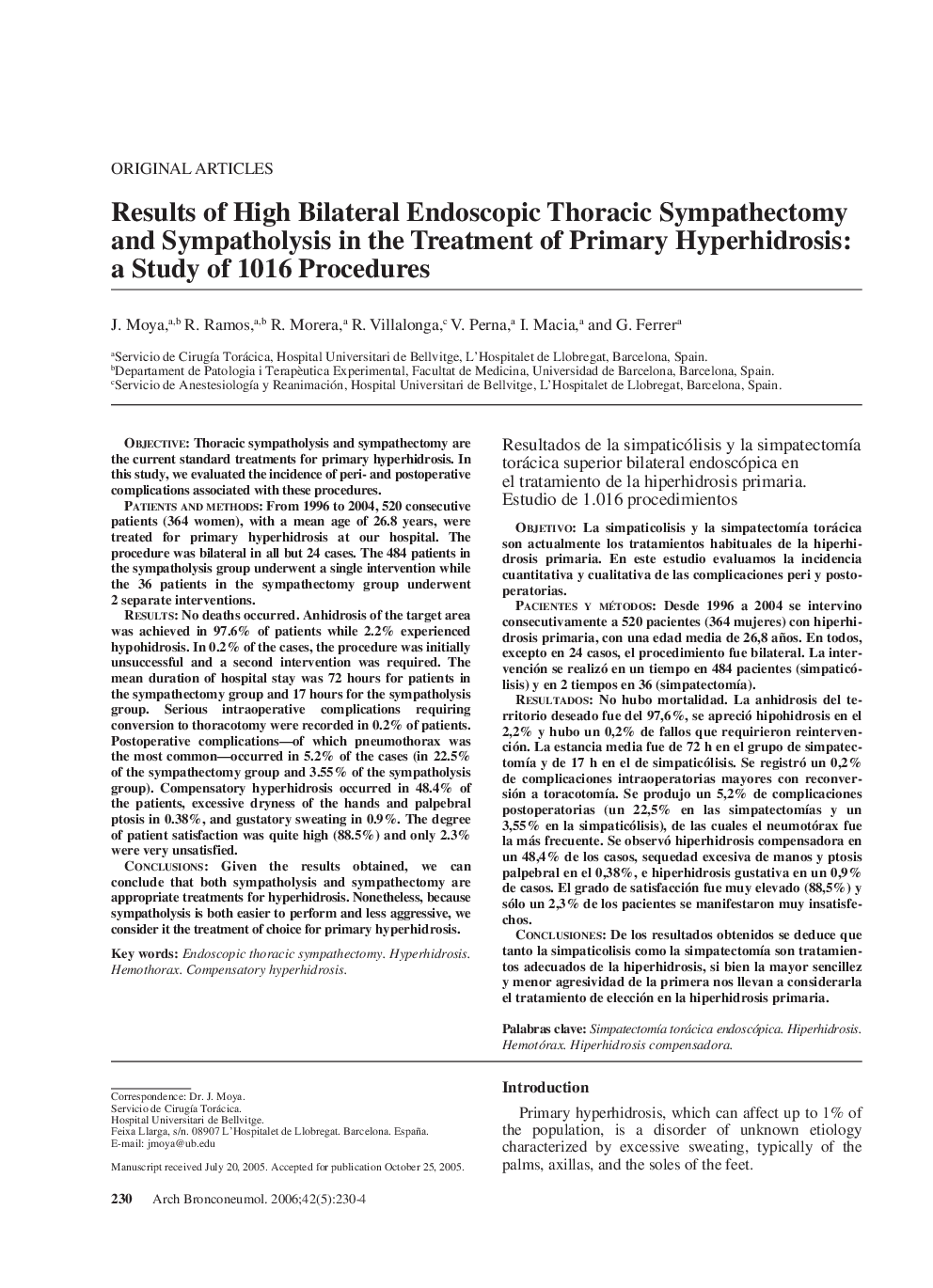| Article ID | Journal | Published Year | Pages | File Type |
|---|---|---|---|---|
| 4206779 | Archivos de Bronconeumología (English Edition) | 2006 | 5 Pages |
ObjectiveThoracic sympatholysis and sympathectomy are the current standard treatments for primary hyperhidrosis. In this study, we evaluated the incidence of peri-and postoperative complications associated with these procedures.Patients and methodsFrom 1996 to 2004,520 consecutive patients (364 women), with a mean age of 26.8 years, were treated for primary hyperhidrosis at our hospital. The procedure was bilateral in all but 24 cases. The 484 patients in the sympatholysis group underwent a single intervention while the 36 patients in the sympathectomy group underwent 2 separate interventions.ResultsNO deaths occurred. Anhidrosis of the target area was achieved in 97.6% of patients while 2.2% experienced hypohidrosis. In 0.2% of the cases, the procedure was initially unsuccessful and a second intervention was required. The mean duration of hospital stay was 72 hours for patients in the sympathectomy group and 17 hours for the sympatholysis group. Serious intraoperative complications requiring conversion to thoracotomy were recorded in 0.2% of patients. Postoperative complications—of which pneumothorax was the most common—occurred in 5.2% of the cases (in 22.5% of the sympathectomy group and 3.55% of the sympatholysis group). Compensatory hyperhidrosis occurred in 48.4% of the patients, excessive dryness of the hands and palpebral ptosis in 0.38%, and gustatory sweating in 0.9%. The degree of patient satisfaction was quite high (88.5%) and only 2.3% were very unsatisfied.ConclusionsGiven the results obtained, we can conclude that both sympatholysis and sympathectomy are appropriate treatments for hyperhidrosis. Nonetheless, because sympatholysis is both easier to perform and less aggressive, we consider it the treatment of choice for primary hyperhidrosis.
ObjetivoLa simpaticolisis y la simpatectomía torácica son actualmente los tratamientos habituales de la hiperhidrosis primaria. En este estudio evaluamos la incidencia cuantitativa y cualitativa de las complicaciones peri y postoperatorias.Pacientes y métodosDesde 1996 a 2004 se intervino consecutivamente a 520 pacientes (364 mujeres) con hiperhidrosis primaria, con una edad media de 26,8 años. En todos, excepto en 24 casos, el procedimiento fue bilateral. La inter-vención se realizó en un tiempo en 484 pacientes (simpaticólisis) y en 2 tiempos en 36 (simpatectomía).ResultadosNO hubo mortalidad. La anhidrosis del te-rritorio deseado fue del 97,6 %, se apreció hipohidrosis en el 2,2% y hubo un 0,2% de fallos que requirieron reinterven-ción. La estancia media fue de 72 h en el grupo de simpatectomía y de 17 h en el de simpaticólisis. Se registró un 0,2% de complicaciones intraoperatorias mayores con reconversión a toracotomía. Se produjo un 5,2% de complicaciones postoperatorias (un 22,5% en las simpatectomías y un 3,55% en la simpaticólisis), de las cuales el neumotórax fue la más frecuente. Se observó hiperhidrosis compensadora en un 48,4% de los casos, sequedad excesiva de manos y ptosis palpebral en el 0,38%, e hiperhidrosis gustativa en un 0,9% de casos. El grado de satisfacción fue muy elevado (88,5%) y sólo un 2,3% de los pacientes se manifestaron muy insatisfe-chos.ConclusionesDe los resultados obtenidos se deduce que tanto la simpaticolisis como la simpatectomía son tratamientos adecuados de la hiperhidrosis, si bien la mayor sencillez y menor agresividad de la primera nos llevan a considerarla el tratamiento de elección en la hiperhidrosis primaria.
